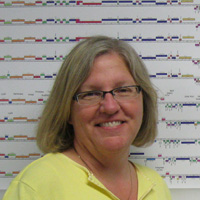Welcome to the forums at seaphages.org. Please feel free to ask any questions related to the SEA-PHAGES program. Any logged-in user may post new topics and reply to existing topics. If you'd like to see a new forum created, please contact us using our form or email us at info@seaphages.org.
Recent Activity
All posts created by debbie
| Link to this post | posted 25 Jul, 2018 16:37 | |
|---|---|
|
|
I am not sure exactly how to answer this without seeing data. Know that we made a decision about 1 1/2 years ago, to call every small gene between the major capsid and the major tail a -head-to-tail connector protein. Those calls should be ignored without HHPred info. If your BLAST hits our phages, you should be able to tell the difference because when we were calling 'everything', the label was "head-to-tail connector". Once we made the change we are labeling true hits to head-to-tail proteins "head-to-tail connector complex proteins". I hope that helps. it is a bit confusing. debbie |
Posted in: Functional Annotation → Head-tail connectors
| Link to this post | posted 24 Jul, 2018 03:49 | |
|---|---|
|
|
The last feature of this genome is not in phamerator or in the gene list on phagesDB: CDS join(16287..16604,1..96) /gene="25" /locus_tag="PBI_EMPEROR_25" /codon_start=1 /transl_table=11 /product="HNH endonuclease" /translation="MTALPAWAGDYSRRLTALCLATYGDTCHLCGRPGATTADHLIPR SVSYDDSLANLRPAHQRCNSARGAMPIETWRARFTASTAPRSSRWSRPSSSLTPQVSA ALRPAAFFSPNAQNKGSVHTEKPSETTKGPDNATT" |
Posted in: Cluster DM Annotation Tips → a wrap around gene at the end
| Link to this post | posted 22 Jul, 2018 02:35 | |
|---|---|
|
|
Maria, I would call both of these. They meet the cut-off criteria that we have set forth. for Neferthena, it looks like the end are called correctly. For Andromedas, you will need to trim the last 2 bases (GA). debbie |
| Link to this post | posted 26 Jun, 2018 21:14 | |
|---|---|
|
|
Germán, Excellent obse4rvaton of the data! -debbie |
Posted in: Frameshifts and Introns → New frameshift in an A1 phage?
| Link to this post | posted 22 Jun, 2018 17:17 | |
|---|---|
|
|
Hi. I sent an email to Dex and Claire about this. Technically, we are not reporting codon or anti-codon but rather the DNA sequence that makes the anti-codon. So I can see why this gets confusing. |
Posted in: PECAAN → PECAAN and tRNA notes problem?
| Link to this post | posted 21 Jun, 2018 21:56 | |
|---|---|
|
|
Evan, GeneMark does call all starts ATG, GTG, and TTG (you will find that GenMark can agree with Glimmer on a TTG start in DNA Master). However, GeneMrk's graphic output is only coded to represent ATG (longer upticks) and TTG (shorter upticks) starts. I think they ran out of money to update all of the graphic displays….. |
| Link to this post | posted 21 Jun, 2018 16:24 | |
|---|---|
|
|
Check out the genes upstream of the tail assembly chaperone (in Adaia, they are genes 8 and 9). it is easy to see that gene 8 is the major tail (HHPred results). Remember that it matches the SPP1 crystal structure project. This gene matches "H" which is a major tail protein and NOT the portal or head-to-tail connector complex protein. I am wondering if there is a legitimate programmed frameshift with this protein. See Baranov, et al 2006 where a major tail +1 ribosomal slippage is cited in a Listeria phage, PSA. While our slippery sequence doesn't match the one found in that major tail protein, our major tail protein - gp 8 - is 140 amino acids, while gp9 is 130 amino acids. A quick look at other major tail proteins across the actinobacteriophages, I have found gp sizes of 170 - 282 amino acids. Just wondering if the major tail protein is in 2 genes in this case. Further review is needed. |
Posted in: Cluster AX Annotation Tips → Major Tail Proteins
| Link to this post | posted 21 Jun, 2018 16:10 | |
|---|---|
|
|
Be careful as you look for the second part of the tail assembly chaperone (T protein). It is a tiny bit of coding potential directly upstream of the tape measure that is not always called (only 1 in 3 have predicted it so far). All of them have same slippery sequence. refer to genome annotations of Adaia, Sputnik, and Atraxa for the exact calls. |
Posted in: Cluster AX Annotation Tips → Tail Assembly Chaperones
| Link to this post | posted 15 Jun, 2018 15:00 | |
|---|---|
|
|
So you may be missing a driver. I am not sure. I have attached a picture of 3 files that should be in your DNA Master folder. Check the root of where these files are (captured in the attached photo) along with the 3 files that should be there. They are Windows files and don't move easily. I am providing one of them becuase it is the one that is usually missing. If you can't access this file from my DropBox, download it from the web. https://www.dropbox.com/s/uzlq44kn958fyma/msvcr100.dll?dl=0 |
Posted in: DNA Master → Important DNA Master Update
| Link to this post | posted 14 Jun, 2018 21:19 | |
|---|---|
|
|
The version is at help -> about. If you have not changed preferences to use secure servers, you will not get blast results. I have attached a picture of the correct settings. |
Posted in: DNA Master → Important DNA Master Update


 37Kb
37Kb